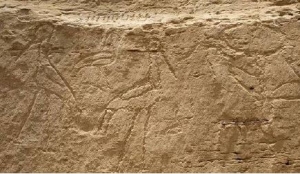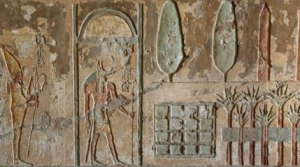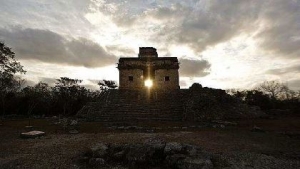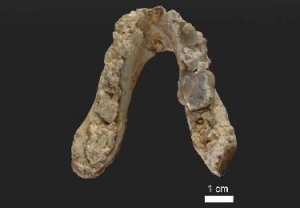Aportadas por el S. I. y colaboradores de España. Síntesis realizada por Manuel J. Ruíz.
Evolución humana
El primer miembro del linaje humano
Un equipo liderado por Madeleine Böhme, de la Universidad de Tubinga, y por Nikolai Spassov, de la Academia Búlgara de Ciencias, ha analizado la dentición de dos fósiles de Graecopithecus freybergi, una especie de primate de hace 7,2 millones de años. Uno, el más completo, fue encontrado en 1944 en Atenas, y el otro es de Bulgaria. El estudio se ha publicado en la revista PLOS One.
Estos investigadores han analizado la dentición con modernas técnicas y han llegado a la conclusión de que no corresponden a los grandes monos, sino que sigue el patrón humano. Por lo tanto, El Greco, (como se conoce jocosamente a este ejemplar griego) sería el primer ancestro dentro del linaje humano.
Esta afirmación de Böhme ha generado una gran discusión científica, pero para esta investigadora no hay dudas: el análisis de la dentición es una prueba suficientemente sólida para sostener esta hipótesis. El equipo ha publicado otro segundo artículo, analizando el paleoclima del Mediterráneo, y llegan a la conclusión de que el desierto del Sahara empieza a formarse hace 7,4 millones de años, por lo que cuando vivió El Greco ya estaba formado. «Este suceso separaría las poblaciones de los ancestros comunes de los chimpancés y los humanos que pudiesen haber vivido en el Mediterráneo oriental hace más de 7,4 millones de años. Los prechimpancés se fueron hacia el sur y los prehumanos hacia el norte», indica Böhme. Por tanto, sitúa el origen del linaje humano fuera de África, como hasta ahora se sostiene por la mayoría de científicos.
https://elpais.com/elpais/2017/05/22/ciencia/1495472412_212902.html
http://journals.plos.org/plosone/article?id=10.1371/journal.pone.0177127
http://www.ancient-origins.net/human-origins-science/72-million-year-old-pre-human-fossil-suggestsmankind-
arose-europe-not-africa?page=0%2C1
Artículo completo:
http://journals.plos.org/plosone/article/file?id=10.1371/journal.pone.0177127&type=printable
Antiguo Egipto
Hallan los jeroglíficos más antiguos
Son cuatro grandes figuras de más de 5200 años de antigüedad y se hallan talladas en una pared rocosa cerca de la ciudad de Nejeb, entre el Nilo y el desierto a 90 km al sur de Tebas. El hallazgo ha sido realizado en una misión arqueológica de la Universidad de Yale y del Museo Real de Arte e Historia de Bruselas.

Se trata de un conjunto de cuatro figuras grandes, de entre 54 y 70 cm de altura, y dispuestos de derecha a izquierda, como serían los textos egipcios posteriores. Representan dos cigüeñas jabirús dándose la espalda, entre las que hay un ibis, y la cabeza de un búfalo en la derecha. Expresan la dominación de cierta autoridad sobre el cosmos. Su uso se remonta a antes de las primeras dinastías faraónicas.
http://www.levif.be/actualite/sciences/egypte-les-hieroglyphes-les-plus-anciens-et-les-plus-grandsdecouverts- a-ce-jour/article-normal-684375.html
Descubierto el primer jardín funerario en Egipto
El equipo que dirige el egiptólogo madrileño José Manuel Galán, del Consejo Superior de Investigaciones Científicas, ha descubierto el primer jardín funerario del Antiguo Egipto. El hallazgo se ha producido en la necrópolis tebana de Dra Abu El Naga (Luxor), dentro del proyecto Djehuty.

Se trata de un jardín de 4 x 3 metros en una tumba de la XII Dinastía del 2000 adC. En él se han encontrado semillas de las especies vegetales plantadas, e incluso 40 cm de un tronco de tamarisco, que aún se hallaba en pie, y que tendría unos 20 años cuando fue tallado. Según refiere Galán, el tamarisco tenía un fuerte contenido simbólico, asociado a Osiris, y en sus ramas se posaría el alma del difunto. Se sabía que los egipcios acostumbraban a levantar, en la entrada de las tumbas, pequeños huertos o jardines rituales, levantados medio metro y compuestos de parterres rectangulares con una planta cultivada en cada uno, pero este ha sido el primer hallazgo de uno real. Nunca se había encontrado,
según José Manuel Galán, “por la manía de los egiptólogos —similar a la de los saqueadores de tumbas— de meterse directamente dentro del sepulcro ignorando y despreciando lo de fuera y pensando que sólo había cosas de interés en el interior. Nosotros hace tiempo que estamos demostrando que en el exterior de las tumbas hay información muy interesante”.
https://elpais.com/cultura/2017/05/04/actualidad/1493892665_016926.html
América Precolombina
Las ciudades mayas distribuidas geográficamente según constelaciones estelares
William Gadoury ha descubierto que las 117 ciudades mayas siguen un modelo de distribución geográfica según la distribución estelar de 22 constelaciones mayas contenidas en el Codex Maya de Madrid. Pero esta noticia, de por sí importante, tiene más facetas que la hacen relevante, porque William es un joven canadiense de tan sólo quince años, gran amante de la cultura maya.
El conjunto de ciudades mayas no siempre sigue un patrón de distribución asociado a cursos de agua u otras características orográficas favorables, y esta circunstancia en sí constituía un enigma. William Gadoury, estudiando las 22 constelaciones mayas, se dio cuenta de que la distribución de las estrellas en el plano espacial, se correspondía con la distribución geográfica de las ciudades, algo que nunca se había sospechado, coincidiendo las estrellas más brillantes con los emplazamientos más importantes.
 Pero además, William ha descubierto que hay una constelación con una estrella sin su ciudad correspondiente, es decir, según esta teoría, faltaría una ciudad maya por descubrir. Y, efectivamente, en el lugar indicado por el joven investigador, una localización en la península de Yucatán (México), el análisis de las imágenes por satélite indica la existencia de una pirámide y unas treinta construcciones cuadrangulares, formas que no se corresponden con fenómenos naturales, según indica el especialista en teledetección Armand LaRocque, de la Universidad de Nouveau Brunswick.
Pero además, William ha descubierto que hay una constelación con una estrella sin su ciudad correspondiente, es decir, según esta teoría, faltaría una ciudad maya por descubrir. Y, efectivamente, en el lugar indicado por el joven investigador, una localización en la península de Yucatán (México), el análisis de las imágenes por satélite indica la existencia de una pirámide y unas treinta construcciones cuadrangulares, formas que no se corresponden con fenómenos naturales, según indica el especialista en teledetección Armand LaRocque, de la Universidad de Nouveau Brunswick.
Ahora sólo falta llegar a la ciudad, que puede ser una de las más importantes, y que se halla en un intrincado lugar de la selva del Yucatán.
http://www.abc.es/ciencia/abci-adolescente-canadiense-descubre-ciudad-maya-desconocida-201605091012_noticia.html



